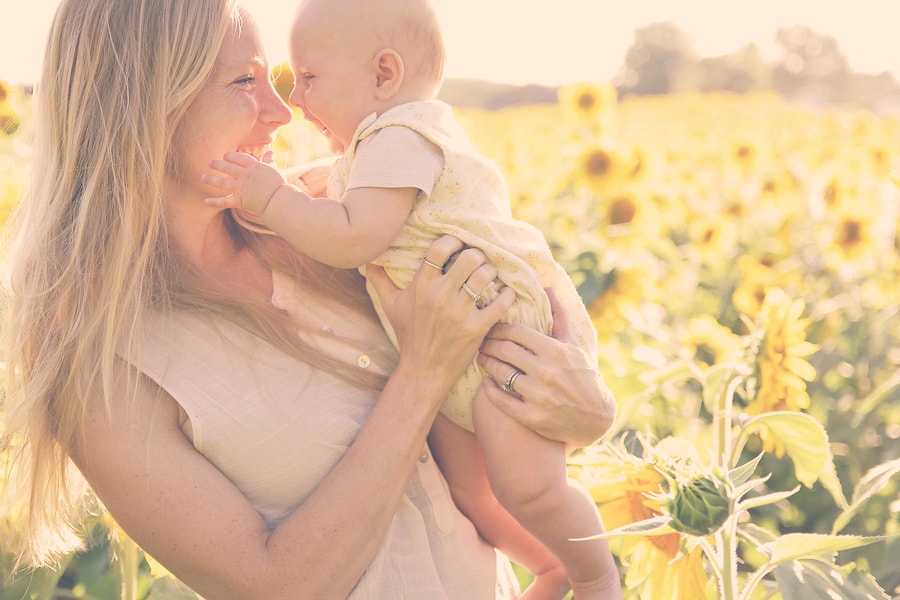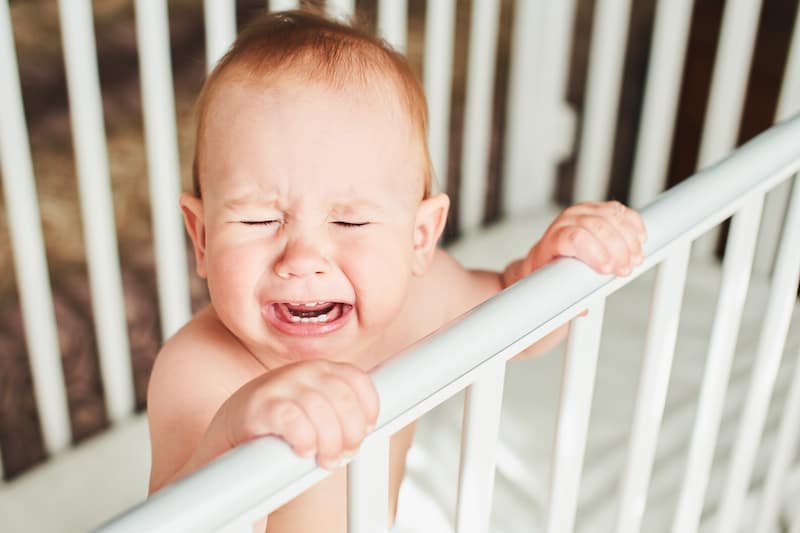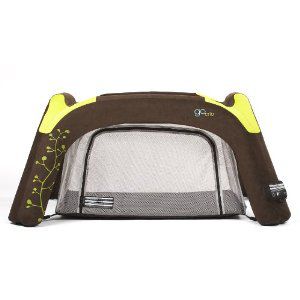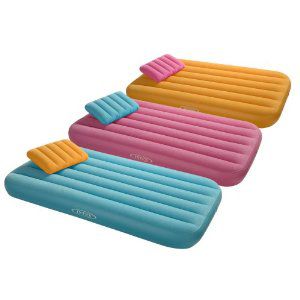We all know/love Aden + Anais for their delicious muslin swaddles, made famous by everyone—from just about every baby-toting celeb on the planet, to every mom in the know—but now they’re batting it out of the park again with their new muslin clothing line. With kimono tops, strategic snaps and covered zippers, I’m wishing they came in mommy sizes.
Trouble catching some Zzz’s? Febreze is here to help! Achieving the recommended seven to eight hours of sleep each night isn’t always easy. To help you get back to a healthy sleeping routine, Febreze is introducing the NEW Febreze Sleep Serenity collection in three scents – Moonlit Lavender, Warm Milk & Honey and Quiet Jasmine. The new collection helps transform any bedroom into a peaceful environment ideal or sleeping. Unwinding during the hours before you climb into bed can make a big difference. Febreze has partnered with the National Sleep Foundation for 5 Tips for Getting to Sleep that will have you counting sheep in no time.
People wonder if it is really that important to encourage babies to sleep on their backs. Many hate to be swaddled and tend to flail and scream unless they are snuggled onto their tummy. Unfortunately, babies are safer on their backs. Ugh. But are there tips to encourage babies to sleep on their backs? Yes. We’ve come up with a few..
1. Always put a baby to sleep on their back. Keep flipping them over if they turn.
2. Pillows or rolled up swaddling blankets on either side can go far towards keeping them stationary.
3. Sometimes an indented or v-shaped pillow works wonders when they are tiny.
4. Feed your baby about 30 minutes before bedtime to try satisfaction with a full stomach.
5. Tuck a favourite blanket or piece of your clothing (snugly) around the baby to provide comfort.
6. Leave the room while baby is still awake.
7. Make a routine with sound, book, lighting – whatever you feel you can sustain and repeat.
8. Eliminate stuffed animals, bumpers and loose blankets. We love sleep sacks and swaddlers.
Babies have an increased risk of dying of SIDS, Sudden Infant Death Syndrome, when they sleep on their stomachs. This is related to the inability to lift their head completely. Once the baby can easily lift and turn its head from side to side-usually about 3-4 months – the baby can sleep on its stomach. You might try propping a baby on it’s side using rolled up towels or receiving blankets (to ensure the rolls are well away from their face) and see if she can sleep in this position.
Up to 30 % of parents of young children encounter difficulty with getting their little ones to fall asleep or stay asleep. Sleep is important for children’s health and development. Lack of sleep in children is known to cause learning and memory deficits resulting in difficulty attaining age appropriate milestones for younger children and poor academic performance in school aged children. It is also reported that lack of sleep in children can result in irritability, depression, hyperactivity and aggression. Moreover, disturbed sleep in children often causes stress on the entire family. Contrary to belief, children do not outgrow sleep problems and if left untreated, sleep disorders are more likely to persist, but many still struggle with ways to get your baby to sleep?
In order for children to learn and develop, they need to be well rested to be at their optimum for taking in new information and accomplishing motor and cognitive milestones. Parents should practice and teach their children good sleep hygiene techniques to promote better sleep. The term sleep hygiene relates to sleep behaviours that expose a child to activities and cues that prepare and promote them for well timed and effective sleep. Here is a top 10 list of good sleep hygiene practices to teach your children:
10 Ways to Get Your Baby to Sleep
• Being active during the day. Age appropriate activities are essential to help children establish good sleep-wake cycles. It exposes them to daylight and activities throughout the day which is thought to help increase the release of a hormone (melatonin) at night to help children sleep. Activities for an infant such as tummy time or a toddler playing at a park on swings, climbing, sliding etc… Children are meant to move and sedentary activities such as television are thought to hinder a good night’s sleep.
• Routines help children understand what is coming next; this allows them to anticipate what is happening in their day.
• Establish a bedtime routine to allow them to wind down and get themselves ready to transition from wake to sleep. Take approximately 30 mins of quiet time doing relaxing activities prior to getting your child to sleep.
• Keep to a fairly predictable schedule during the week and weekends e.g. bedtime/naptimes should not vary more than one hour either side of regular bedtime. Most children are in bed by 730pm every night. Autumn is the best time to put children to bed earlier and benefit from the daylight savings time change to help with the transition.
• Try not to feed your child food containing caffeine 4-6 hours prior to bedtime (e.g. cookies or muffins containing chocolate), it acts as a stimulant and keeps children awake.
• The Canadian Paediatric Society recommends no television for children under two years of age. If you let your child watch television ensure that they do not watch any at least 2 hours prior to bedtime, this activity stimulates children instead of calming them. Try reading a favourite book or singing some bedtime songs to help transition them to calmer activities.
• For younger children, research studies report that infants who learn to settle themselves are more likely to discover self-soothing techniques and are better sleepers by 6 months than infants whose caregivers assist infants to sleep through various activities e.g. feeding or rocking to sleep.
This does not mean letting your child cry it out but rather letting them settle themselves.
• Noise reduces sleep time, especially in deep sleep, and increases light sleep e.g. a party going on at next door neighbours. During light sleep, noises can wake a person more easily. Try using a white noise machine.
• When the room temperature is too hot, time in deep sleep is decreased. In a room too cold, it takes longer for a person to get to sleep. Recommended room temperature for sleeping is between 16 and 20 degrees Celsius.
Need more ideas? We’ve rounded up the ‘experts’ – Elizabeth Pantley and Richard Ferber.
Jennifer Garden, a registered health professional (occupational therapist) and mother of two year old twins!
Urban Mommies always seem to be on the go, especially in the summer! When traveling with our little ones, finding a comfy place for them to sleep can be a source of concern. It’s easy to feel like Goldilocks in the house of the Three Bears: our children are too big for a pack-n-play or a crib but they are too small to be comfortable in a large adult bed. What’s a mom to
do? We need to find a bed that is just right, and these travel beds for small children do the trick.
The solution? A Travel bed specially designed and shaped to accommodate infant/toddler and young child age groups. There is an assortment from which to choose including: inflatable air mattresses, simple and light-weight cots, lightweight play yards many of which come with a bassinet for small babies. Some travel beds are also equipped with folding bed rails for children who have a tendency to roll out of bed in the middle of the night. Most importantly, because many of the travel beds are inflatable, they are also quite portable, light-weight and c
an easily be folded to fit into a car or a closet.
Several makers of child travel beds and different styles of travel beds are available.The Urbanmommies Editors found the following child and infant travel beds particularly pleasing:
Unlike the hardier and bulkier play yards of our youth, the PeaPod Plus Baby Travel Bed is more like a “travel cocoon.” The mattress is inflatable and, when baby is finished sleeping, can be folded into a compact tote for easy carrying; no more lugging around the heavy pack-n-play! This travel bed is also outdoor-friendly: the mesh bubble blocks bugs, wind, and half of the UV rays. The mattress inflates in less than 5 minutes using the a specific pump (sold separately by Leaps and Bounds).
The GoCrib is a standard size, ultra-portable travel crib that packs into a lightweight backpack for families that are on the go. Because it’s inflatable, it is pretty easy to assemble. But, once it is set up the rigid structure creates a strong and safe environment. The product features a 27″ x 39″ insulating mattress and a 25″ depth sleeping and play area (same as a standard play yard).
I wish that they had something like the My Cot Portable Travel Bed when I was a child. It would have made sleeping at my grandparents’ house a lot more comfortable. This portable cot can go to Grandma’s, day care as easily as it can be transported to sleepovers! The bed is slightly lifted off the ground leaving enough room underneath to ensure that the children sleeping on it stay comfy and dry whether the cot is indoors and out. It even comes with its own carry bag.
We love the Tuck-Me-In Travel Bed with Removable Mattress. It’s so easy to assemble my daughter and her cousins argue about how’s turn it is to inflate the mattress. The famous inflatable bed features a larger, fully-detached mattress, for snugglier sleepovers and easier linen changes. Soft and cushy, with a flocked surface that’s not sticky, it also built-in safety bumpers. The Tuck-Me-In is very light and folds compactly. The pump and tote included in the price of the bed. Further, if your little one is a sheet lover, like my daughter is, you can purchase the coordinating travel bed accessories from One Step Ahead too.
My 8 year-old daughter is begging me for a bed that can accommodate all her friends when they have a sleep over. Rather than pull out the old sleeper sofa’s mattress, we elected to go the less time consuming and affordable route and took a look at the Cozy Kidz Airbeds. The Intex Cozy Kid Air Bed Twin Size comes in three bright fun colors: pink, blue and orange . Both the pillow-top and mattress-top are lightly flocked which adds comfort while also preventing the sheets from sliding off of the mattress. This is the perfect air mattress to take on a sleepover or even family camping trips. The beds are 34.5″ Wide x 62″ Long x 7″ height (slightly shorter than the average twin bed) but the dimensions may vary up to two inches depending on firmness and come with built in pillows. Even better? The mattresses can withstand more than 200lbs which means more than one child can sit on it at a time before having to worry that they are going to cause the mattress to deflate. One note, the mattress does not come with a built in pump.
Traveling with small children doesn’t have to be painful. Most Urban Mommies know that the first step to having a happy child is ensuring that child has had a good night’s sleep. With so many great travel bed choices, we know that you & your family will find the right one (or two? or three?) that works for you.
Good luck! And safe travels!
Want to see a bunch of new moms come to blows faster than teams in a Stanley Cup playoff? Mention infant sleep training – and then talk about Richard Ferber. We review his ideology so you can pick a side for the fight. Just remember, you are the parent and your own instincts blended with your baby’s cues cannot be preached at by anybody, no matter how much of an offence they can play. (And moms also reserve the right to change their mind if their first choice doesn’t work). Here is an overview of Baby Sleep Methods from Richard Ferber.
The Ferber Method
Infant sleep problems are what a lot of parents are normally confronted with as a challenge in raising their children. Dr. Richard Ferber, in an attempt to help solve these problems proposed a couple of methods to be used in sleep training for infants and children. These methods are now popularly referred to as Ferberization techniques. In a nutshell? The parent leaves the baby to cry for a predetermined time before giving external comfort that will put the baby to sleep.
The wide array of techniques for infant sleep training as proposed by Richard Ferber includes taking steps to prepare the baby for sleep. This involves a number of day time and bed time activities – a routine that the baby can easily associate with sleep. It also entails leaving the child in bed and leaving the room at bedtime. The parent can return to comfort the baby at progressively increasing intervals without picking the baby up. This should be done till the baby falls asleep. As the days go by, the intervals for returning to comfort the baby should be increased progressively. Ferber is often misunderstood. He does condone flexibility, such as when a child is ill, traveling or has a babysitter, but stresses the importance of the routine and the lack of positive reinforcement that a baby receives for crying in order to be soothed to sleep.
The Sleep Training Controversy
This ‘training’ usually takes place between 4 and 6 months of age. However, different parents may get different results using these techniques. The controversy comes about when experts try to determining whether infants become insecure and are scarred for the future if they are left to cry at all.
Whatever your opinion, bringing up the topic in a group of new moms is always quite exciting. Just be prepared to win or lose friends..
For more information about training a baby to sleep, visit: www.childrenshospital.org
![]() Ask any parent about the most difficult part of having a baby and we are willing to bet that SLEEP will be among the top three. Our handy sleep tracker chart can at least help you to figure out when sleep is happening, and if there are any trends towards lengthier slumber! We have a ton of articles on sleep as well if you need some guidance. Baby Sleep Tracker
Ask any parent about the most difficult part of having a baby and we are willing to bet that SLEEP will be among the top three. Our handy sleep tracker chart can at least help you to figure out when sleep is happening, and if there are any trends towards lengthier slumber! We have a ton of articles on sleep as well if you need some guidance. Baby Sleep Tracker
Q – I have a 4.5 month old son, whom I swaddle for all naps and bedtime. He does not sleep for longer than 3 or 4 hour stretches – much to our fatigue/frustration and I am nervous about weaning him out of his swaddle as the lack of sleep is difficult to deal with let alone what it would be like to have him swaddle-free (He is able to free himself of the swaddle most times when he wakes up and is left for a bit in his crib). I tried going without the swaddle for 2 naps and he kept himself up and cranky by grinding his hands into his eyes. I am nervous that I might be affecting his development as he does not roll over yet etc. Is there a maximum recommended age for swaddling and if you are weaning from the swaddle, is there a recommended process? Any help would be much appreciated – thanks!
During the time changes that happen twice a year – children’s sleeping patterns often get thrown off – here are some tips to help with the springtime changes when the clocks go forward by one hour. This article is written based on a baby or child who goes to bed at 7pm and wakes at 7am.
APPROACH 1) – Cold turkey
- On the evening of the time change – put your baby/child to bed at the normal time (7pm) and before you go to bed move all of your clocks forward by one hour.
Q – My baby is 3 months old and will only go to sleep if I feed him. He cries if I try to rock him or sing to him. Sometimes, I feed him for 45 minutes before he falls asleep. When I take him to his crib I have to carefully put him down. If he wakes up, the cycle starts again. Also, if I burp him he wakes up. If I don’t burp him he wakes up 30 minutes later and he needs to be burped. This is exhausting for me. Any suggestions?










